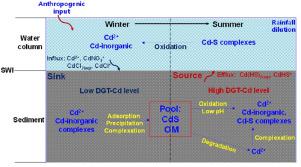Water Research ( IF 12.8 ) Pub Date : 2021-10-13 , DOI: 10.1016/j.watres.2021.117751 Lei Gao 1 , Rui Li 2 , Zuobing Liang 2 , Lei Hou 3 , Jianyao Chen 2

|
Understanding the speciation and mobilization mechanisms of potentially toxic metals in sediments is critical to aquatic ecosystem health and contamination remediation in urban rivers. In this study, chemical sequential extraction, a thermodynamic chemical equilibrium model (Visual MINTEQ ver. 3.1), diffusive gradient in thin films (DGT), and high-resolution dialysis (HR-Peeper) techniques were integrated to identify seasonal variations in cadmium (Cd) mobility in sulfidized sediments. Acid-soluble Cd was the dominant geochemical fraction in sediments, followed by residual, oxidizable, and reducible Cd. The DGT-labile Cd concentration was associated with various geochemical processes and was independent of the total concentration and geochemical fractionation of Cd in sediments. Sulfate reduction facilitated the formation of insoluble CdS and induced low Cd concentrations in sediment porewater. Sulfide oxidation was principally responsible for lowered porewater pH and elevated Cd concentrations in summer. Strongly acidic conditions promoted release of sediment Cd but might reduce the binding efficiency of Chelex resin gel for dissolved Cd, leading to underestimation of the mobility of sediment Cd. Sediments generally functioned as a sink for Cd in winter and shifted to acting as a source in summer, releasing Cd into the overlying water mainly as Cd-S complexes with high potential to migrate downstream.
中文翻译:

基于被动采样技术和热力学化学平衡模型的华南西支河流域沉积物中镉(Cd)形态和迁移率的季节性变化
了解沉积物中潜在有毒金属的形态和迁移机制对于城市河流中的水生生态系统健康和污染修复至关重要。在这项研究中,化学顺序提取、热力学化学平衡模型(Visual MINTEQ 版本 3.1)、薄膜扩散梯度 (DGT) 和高分辨率透析 (HR-Peeper) 技术被整合以识别镉的季节性变化。 Cd) 在硫化沉积物中的迁移率。酸溶性 Cd 是沉积物中的主要地球化学成分,其次是残留的、可氧化的和可还原的 Cd。DGT 不稳定的 Cd 浓度与各种地球化学过程有关,并且与沉积物中 Cd 的总浓度和地球化学分馏无关。硫酸盐还原促进了不溶性 CdS 的形成,并导致沉积物孔隙水中的 Cd 浓度降低。硫化物氧化是夏季孔隙水 pH 值降低和 Cd 浓度升高的主要原因。强酸性条件促进了沉积物 Cd 的释放,但可能会降低 Chelex 树脂凝胶对溶解 Cd 的结合效率,导致低估沉积物 Cd 的迁移率。沉积物通常在冬季充当 Cd 的汇,而在夏季则转变为 Cd 的来源,主要以 Cd-S 复合物的形式将 Cd 释放到上覆水中,具有向下游迁移的高潜力。强酸性条件促进了沉积物 Cd 的释放,但可能会降低 Chelex 树脂凝胶对溶解 Cd 的结合效率,导致低估沉积物 Cd 的迁移率。沉积物通常在冬季充当 Cd 的汇,而在夏季则转变为 Cd 的来源,主要以 Cd-S 复合物的形式将 Cd 释放到上覆水中,具有向下游迁移的高潜力。强酸性条件促进了沉积物 Cd 的释放,但可能会降低 Chelex 树脂凝胶对溶解 Cd 的结合效率,导致低估沉积物 Cd 的迁移率。沉积物通常在冬季充当 Cd 的汇,而在夏季则转变为 Cd 的来源,主要以 Cd-S 复合物的形式将 Cd 释放到上覆水中,具有向下游迁移的高潜力。



























 京公网安备 11010802027423号
京公网安备 11010802027423号